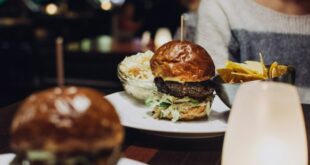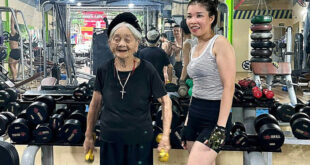Before each meal, Linh, a 37-year-old man, drinks a glass of water as a starter, then eats vegetables, meat, fish and finally rice.
The idea is to “reverse eat” in order to lose weight.
With this regime, Phan Ha Linh consumes more in the morning and at lunchtime, and reduces his food intake in the evening. Due to alarming indicators such as high blood fat, liver enzymes and cholesterol, he combines reverse eating with intermittent fasting to achieve faster weight loss.
Linh is 1.76 meters tall with muscular arms from gym workouts. He used to exercise regularly and maintained a weight of 75-80 kg. However, due to the nature of his work, he neglected exercise and consumed processed foods without control, causing his weight to increase to 110 kg.
Initially, Linh had difficulty controlling his meals due to the nature of his work which forced him to work early mornings and late nights. He needed to drink alcohol and beer. Eating a lot of vegetables prevented him from feeling bloated or full, even though he consumed protein-rich foods beforehand.
To add changes to his diet, Linh eats a variety of fruits and vegetables, prioritizing seasonal foods. When dining out, he avoids eating fatty meats or greasy dishes and drinks in moderation. “If you eat vegetables when you’re hungry, you quickly feel full and don’t want to eat too much. Eating vegetables makes it easier to control the amount of food going into your body,” he said.
He still consumes a balanced diet and limits starches instead of eliminating them completely. Instead of having three main meals, he eats 5-6 meals a day without feeling overly full. For snacks, he chooses fruits to feel satisfied while avoiding cravings.
He selects fruits with low sugar content such as cucumbers, green beans, grapefruits, dragon fruit, green apples, pears, oranges and lemons. He avoids eating mangoes and durians.
According to experts, one of the most principal factors in weight loss is calorie deficit, meaning that the amount of calories consumed must be less than or equal to the amount of calories burned.
Daily calorie intake (calories in) includes food and drinks. Calorie expenditure (calories out) includes metabolic processes, regular activities (including breathing and sleeping and physical exercise).
Water plays a vital role in this entire process. Firstly, water contains no calories. Therefore, using filtered water as a substitute for other beverages like soda, fruit juice, or hot drinks is an effective way to reduce calorie intake.
Consuming beverages that create a feeling of fullness also helps reduce daily food intake, thus reducing calories. Therefore, drinking plenty of water before a meal has helped Linh lose weight effectively.
Similarly, Dr. Nguyen Van Tien, from the National Institute of Nutrition, stated that the reverse eating rule is a scientifically sound approach to weight loss and body shape recovery, ensuring adequate nutrients without the need for starvation. Those who want to lose weight should increase their intake of high-fiber, low-energy foods such as vegetables, slightly sweet fruits, fish and tofu to feel full longer.
The habit of eating vegetables first is also beneficial for digestion, making it easier for the body to metabolize food. Dividing meals into smaller portions is also a way to lose weight instead of eating fewer but larger meals.
You should stick to your usual menu but make adjustments as necessary. In addition, individuals aiming for weight loss need to ensure an adequate intake of meat, fish, protein and carbohydrates while reducing high-energy foods such as fatty or sweet foods.
To promote the body-shaping process, Linh decided to skip breakfast and practice intermittent fasting. This is a cyclic eating and fasting regime that allows the body enough time to fully digest food while strictly limiting calorie intake. There are two forms of intermittent fasting: time-restricted feeding (eating within a 6-8 hour window and fasting for the remaining 16-18 hours) or continuous fasting for 16 to 24 hours, twice a week.
In the first week, Linh often felt hungry, leading to uncontrolled cravings and discomfort. Many evenings when he returned from work and saw food on the dining table, he wanted to dive in and eat immediately. While working, he felt distracted, tired and constantly thought about food.
The thought that it wouldn’t hurt to have just a bite kept lingering in his mind, but when faced with his obese body, Linh hesitated to pick up his chopsticks.
In addition to the dietary regime, Linh combined it with exercise. He cycled every day to burn more calories. In the first two months, he lost 12 kg, but his body didn’t undergo significant changes. He reached a weight loss plateau and his eating experience wasn’t enjoyable.
Occasionally, when going out for drinks, he had to force himself to vomit due to excessive alcohol consumption and high protein intake. This was the most difficult stage of his weight loss journey.
To improve the situation, he chose one day of the week to indulge, meaning he ate whatever he wanted, and then resumed the reverse eating and intermittent fasting routine. When going for coffee, he preferred unsweetened fruit-infused water to avoid feeling bloated. Three months later, he had lost an additional 7 kg.
Currently, Linh maintains a weight of 75 to 77 kg. He shares his experience with others, believing that 70 to 80% of weight loss success is due to diet. However, he emphasizes that weight loss is a personal journey that has no secret or any specific formula.
“Only when you realize that weight loss is beneficial for your health and no longer feel constrained during meal times will you achieve successful and safe weight loss,” Linh said.
- Reduce Hair Loss with PURA D’OR Gold Label Shampoo
- Castor Oil Has Made a “Huge” Difference With Hair and Brow Growth
- Excessive hair loss in men: Signs of illness that cannot be subjective
- Dịch Vụ SEO Website ở Los Angeles, CA: đưa trang web doanh nghiệp bạn lên top Google
- Nails Salon Sierra Madre
 VnExpress News The News Gateway of Vietnam
VnExpress News The News Gateway of Vietnam





